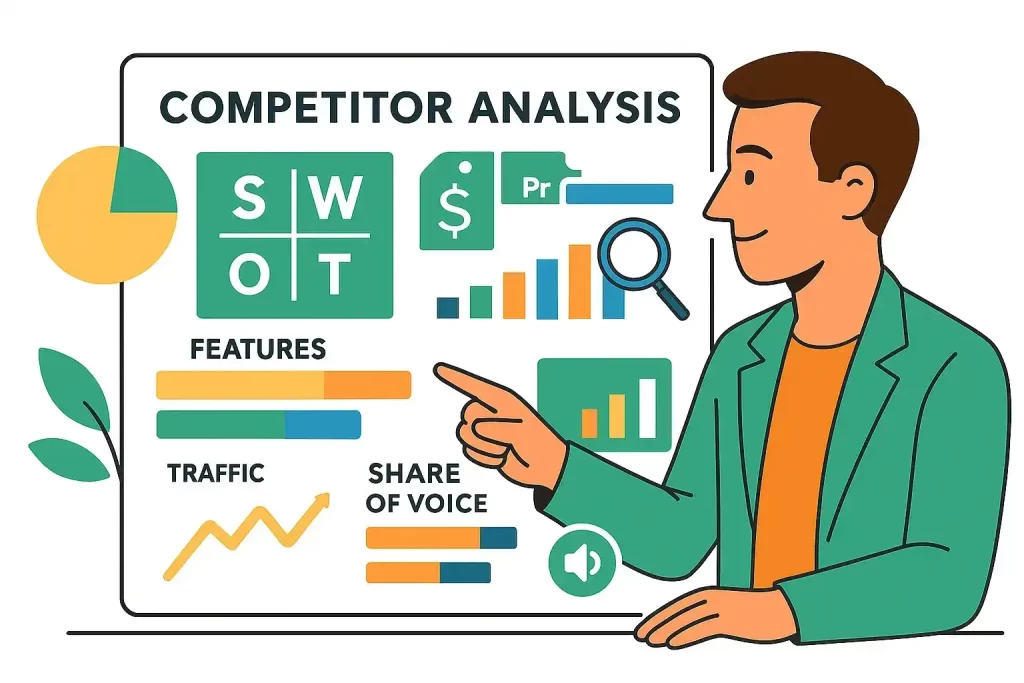Simple Digital Marketing Competitor Analysis for Entrepreneurs
Starting a business is challenging, and the online world is highly competitive. Therefore, you can’t just guess what will work; you need to know what your rivals are doing. Competitor Analysis in Digital Marketing is like getting a map of the battlefield before you start fighting. It shows you what’s working for others and, more importantly, where they are weak. This guide will give you a simple plan to check your rivals and find your edge.

Step 1: Find Your Real Competitors
Identifying the right companies to watch is the crucial first step. Often, entrepreneurs only think of direct competitors (those selling the exact same service) for digital marketing. However, you must also analyse companies competing for your customers’ attention online.
How to Find Them:
- Direct Rivals: Who sells the same thing?
- SEO Rivals: Who shows up on Google when you type your main keywords? For example, a local bakery might see national food blogs ranking for a recipe, even if they don’t sell bread.
- Ad Rivals: Who is running ads when you search for your service?
Once you have this list, you can start digging into their strategies. Clearly, looking at just three to five top rivals is usually enough to begin.
Step 2: Digital Marketing Competitors’ Online Tactic Analysis
Now it’s time to check their methods. Remember, you want to see what is driving their success and what holes you can fill.
1. SEO and Keywords
How do people find them on Google? This is the heart of SEO (Search Engine Optimization).
- Check their Keywords: What phrases are they ranking for? Specifically, look for terms where they are ranking well, but the content seems weak. Because these are easy wins for you.
- Look at Top Pages: Which pages get the most traffic? Often, these high-traffic pages hold a secret to their best customers.
2. Content and Lead Generation
What kind of free information are they giving away? Furthermore, how are they turning website visitors into leads (potential customers)?
- Content Types: Do they mostly use blog posts, videos, or detailed whitepapers? If they only write short blogs, you can stand out by creating long, “ultimate guides.”
- Lead Magnets: What are they asking for in return for an email address? For instance, a free template, a pricing guide, or a quick tool. If their free offer is boring, you can create a better, more helpful one.
3. Social Media and Ads
Where are they spending their time and money online?
- Social Channels: Are they active on LinkedIn (B2B), Instagram (visual/lifestyle), or TikTok (quick tips)? Consequently, you should focus your efforts where your audience is, not where your rival is most active.
- Ad Strategy: Are they running Google Ads or Facebook/Instagram ads? Since ads are expensive, if a rival runs the same ad for months, it means the ad is profitable. You can check this by using tools like the Facebook Ad Library.
Step 3: Analyze Your Digital Marketing Competitive Edge
The goal is not to copy your rivals; it’s to find a way to be different and better. Therefore, use the analysis to spot gaps.
| Rival Strategy | The Gap (Your Opportunity) | Your Action |
|---|---|---|
| They rank for “tax help” | They’re missing the specific keyword “tax help for freelancers.” | Publish a deep-dive blog + dedicated service page targeting freelancers. |
| Their social media is only on Facebook | Many target buyers are active on LinkedIn. | Shift focus to high-quality LinkedIn posts and ads; build a LinkedIn-first calendar. |
| Their free download is a simple checklist | They lack high-value, practical tools. | Create an interactive ROI calculator (lead capture + email follow-up sequence). |
In conclusion, your competitive advantage usually lies in being more focused (targeting a smaller niche) or more valuable (creating better content and tools).
❓ Frequently Asked Questions (FAQ) on Competitor Analysis Digital Marketing
What is the best free tool for basic Digital Marketing competitor analysis?
Start with Google Search and the Facebook (Meta) Ad Library. The Ad Library shows all active ads your competitors are running. A quick Google search of your main keywords reveals their top-ranking pages and content themes.
How often should I check my competitors?
Run a deep audit every 6 – 12 months. In between, do a light check monthly, scan their social feeds and blog for new campaigns, format changes, or positioning shifts. In Digital Marketing Competitor Analysis, Track launches and pricing updates as they happen.
How does competitor analysis help my SEO strategy?
It highlights which keywords and content formats drive results for rivals, so you can target proven terms and publish the formats that rank (e.g., guides, tools, comparisons). You’ll also spot gaps you can own and SERP features worth optimizing for.
















